Year 5 and 6 spelling list – Best worksheets and resources
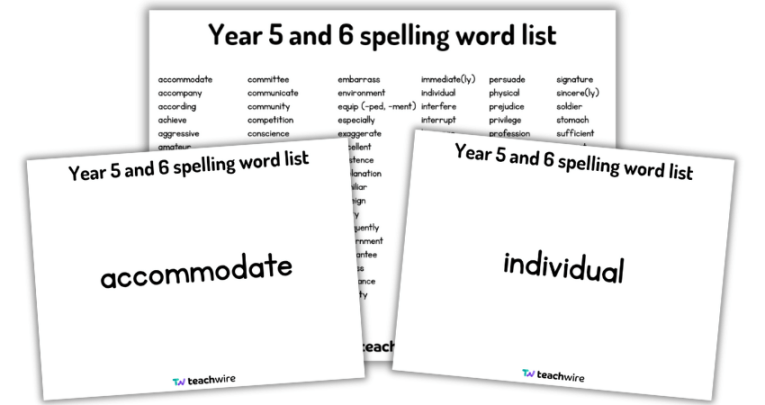
Make sure your upper KS2 students have a firm grip on spelling with these excellent ideas, activities, lessons and more…

- by Teachwire
- Classroom expertise and free resources for teachers
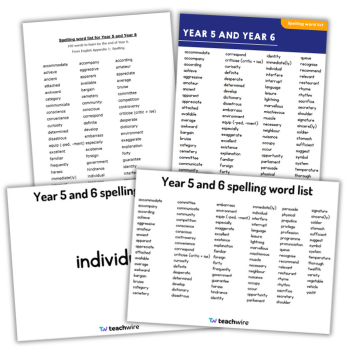
Delve into the Year 5 and 6 spelling list with these comprehensive spelling worksheets and resources for UKS2. We discuss effective strategies and common pitfalls in teaching spelling in KS2, and provide guidance on supporting pupils who are falling behind…
(If you’re looking for Year 3 and Year 4 spelling lists, we’ve also got you covered.)
Year 5 and 6 statutory spelling word list
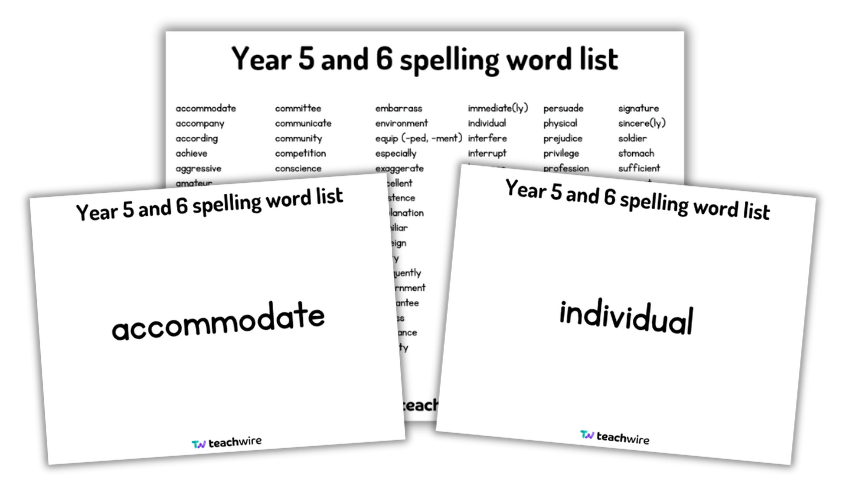
There’s nowhere better to start than the actual list of 100 common exception words that are statutory for Year 5 and 6 students to know how to spell, right?
Presuming you haven’t got them committed to memory, from ‘accommodate’ to ‘yacht’, we’ve created simple PDF, editable Word document and PowerPoint versions of the spelling list for Year 5 and 6.
Spelling worksheets for KS2
100+ free worksheets
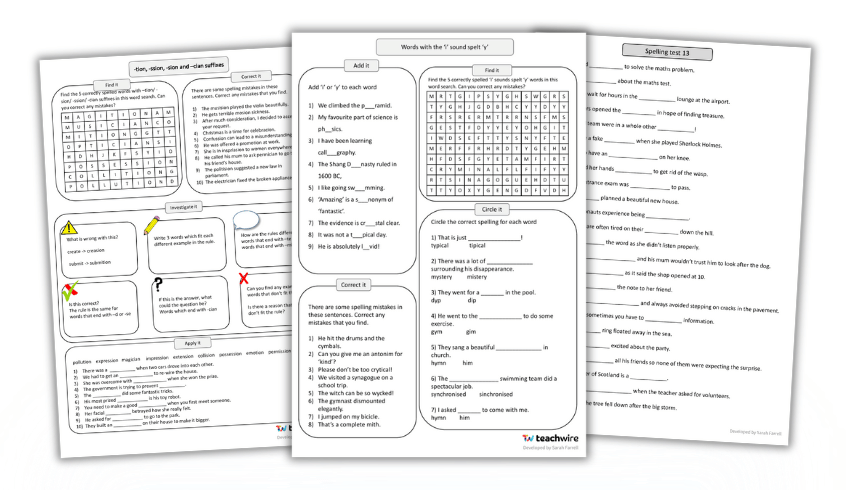
This extensive pack of ready-made spelling games worksheets for KS2 features a huge number of activities, including for prefixes, suffixes, spelling patterns for sounds, homophones and near-homophones, and ‘spot the spelling mistakes’ games.
Year 5 and 6 spelling revision worksheets

These free KS2 spelling worksheets cover all of the Y5/6 statutory spelling words across five challenging worksheets, each containing three different types of spelling check challenges, including anagrams and cryptic clues.
Year 5 spelling resources
Year 5 spellings SATs practice papers

This pack from literacy resources website Plazoom contains six practice SATs papers for KS2. These SATs spelling tests are perfect for assessment at the end of each half term of Year 5.
Each Year 5 spelling test worksheet contains 20 questions and an answer sheet, and a question overview list indicates which spelling patterns are covered by each question, so that you can easily see which spelling patterns need further support.
Year 6 spelling resources
Year 5/6 spelling bingo

This spelling bingo resource pack for Year 6 is a fun way to support children in practising key spelling patterns. It revisits spelling patterns from Lower Key Stage 2 as well as Year 5 and 6 spelling patterns, and can be played as a class or in small groups. There’s also a Year 5 pack.
Multiple Year 6 spelling word lists
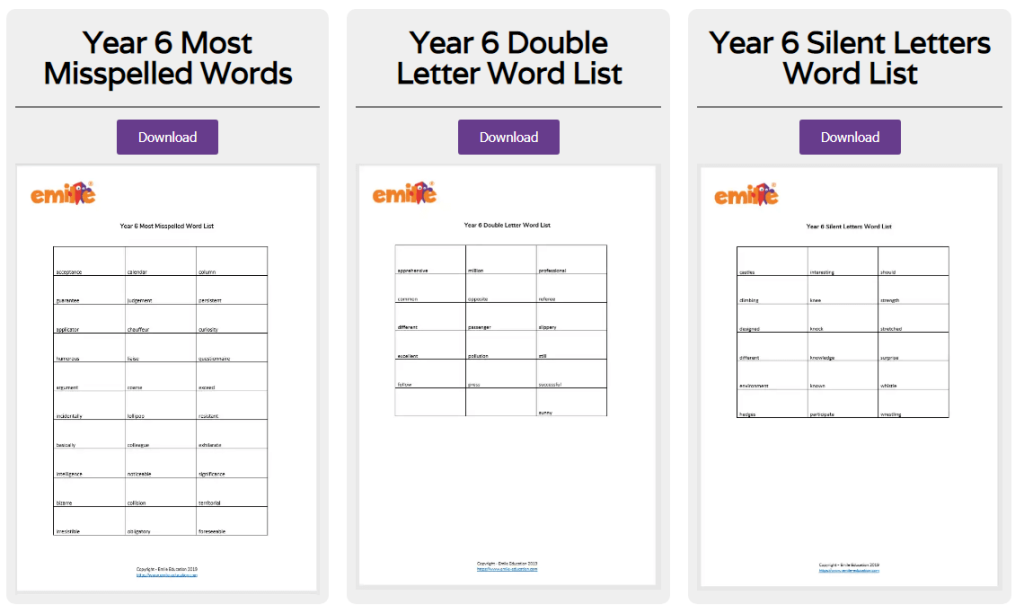
These downloadable lists of Year 6 spelling words are sorted into various groups. There’s a high-frequency words list, one for words that are nouns and verbs, as well as most misspelled, silent letters, double letters and more.
More Year 5 and 6 spelling list resources
Custom word lists
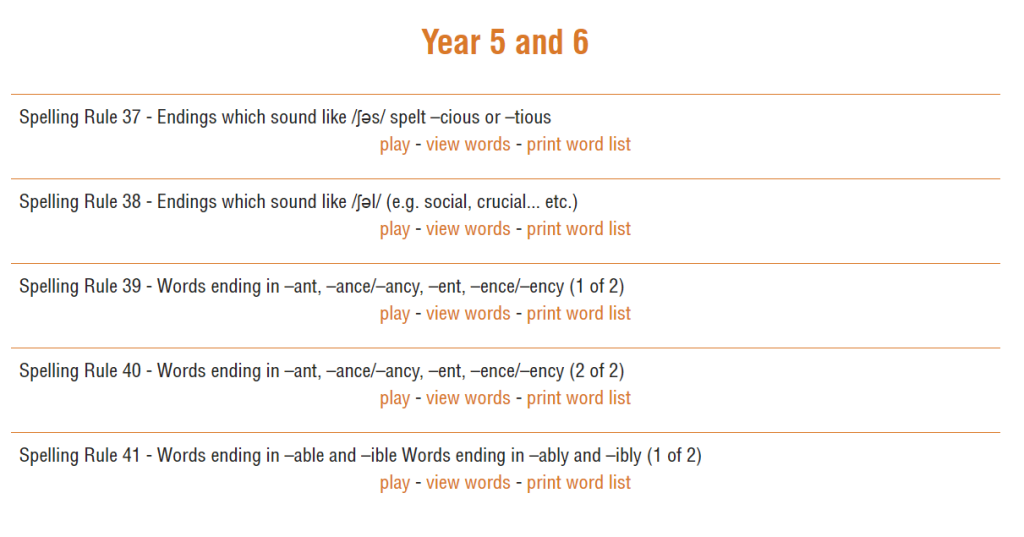
At SpellingFrame you pick a year group, then a spelling rule, then get a word list to either view, print or test yourself with online.
So, for example, you can choose from adding suffixes beginning with vowel letters to words of more than one syllable, words with the /s/ sound spelt sc, homophones and near-homophones, and more.
In the interactive tests, children can opt to have the entire sentence read out, or just the word they need to spell.
Year 5 and 6 spelling word search revision pack

Help children to master all of the words from the Year 5 and 6 spelling lists with these word search activities from Plazoom.
There are seven different word searches in this pack which together cover all of the Year 5 and Year 6 spellings on the English curriculum.
Tips for remembering silent letters
This short BBC Teach video has some handy advice for remembering the silent ‘n’ in words like ‘hymn’ or ‘autumn’, and the silent ‘t’ in ‘hustle’ and ‘wrestle’ among others. It’s well worth a watch.
Spelling crime scene investigators
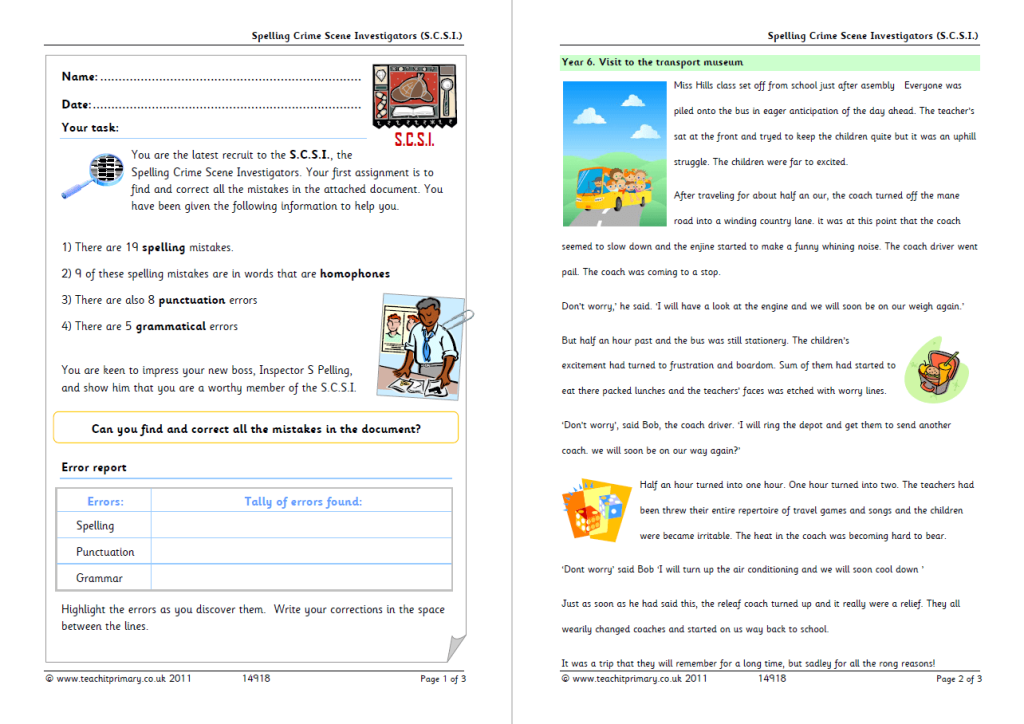
This proof-reading resource is suitable for Y5/6 children and focuses on grammatical, spelling and punctuation errors.
The PDF includes a report about a class trip to a museum. There are 19 spelling mistakes to spot, as well as eight punctuation errors and five grammar slip-ups.
‘-ent’ and ‘-ence’ endings
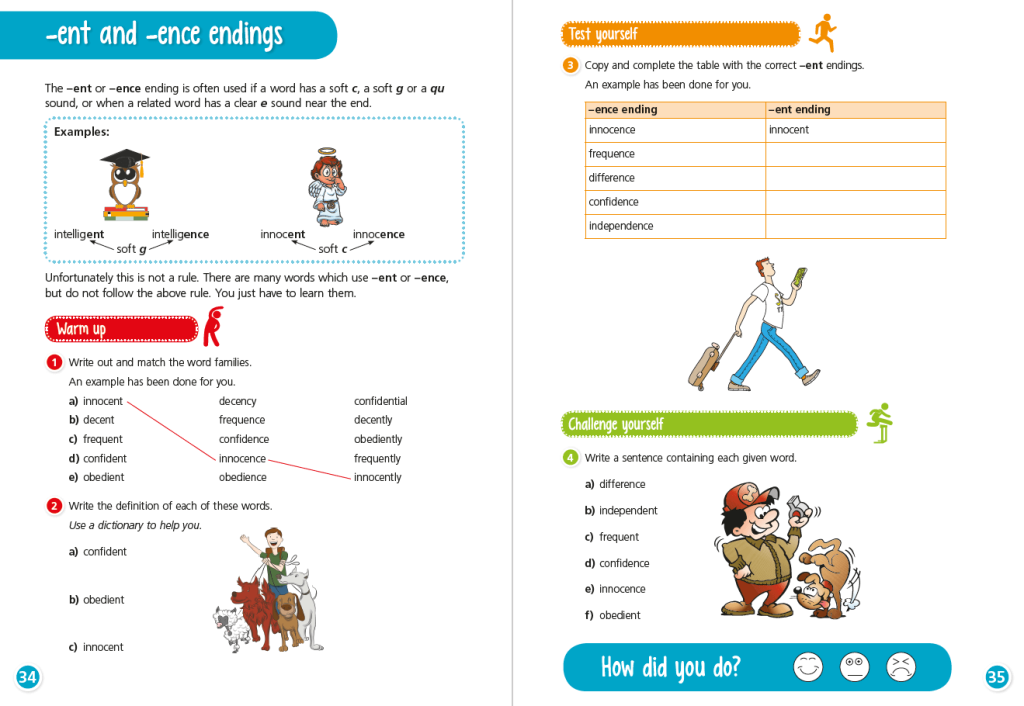
This free six-page resource is from Keen Kite’s Ready, Steady, Practise! – Year 6 Spelling series. There are question and answers plus guidance for pupils.
How not to teach spelling in KS2

Modelling invented words in spelling lessons? Teaching spelling ‘rules’? Saying that letters are ‘silent’? No, no, no, says Charlotte MacKechnie…
If you allow a child to spell ‘he’ as ‘hee’ or ‘they’ as ‘thay’, they’re going to practise misspelling these words.
They’ll become so familiar with their invented spellings that they may struggle to unlearn the inaccurate sound-spelling correspondences. I use ‘invented spelling’ because the notion of ‘phonetically plausible’ spelling is flawed. All spellings are phonetic. If a word wasn’t ‘phonetic’, you wouldn’t be able to say it.
Anything that is spoken can be represented with various combinations of the 26 letters in the English alphabet. English language spelling has been standardised since the 1700s, yet pronunciation is constantly evolving.
While many different words are certainly complex to spell, they are not phonetically irregular.
Spelling strategy
Unfortunately, it appears to be common practice for EYFS and KS1 teachers to model ‘phonetically plausible’ (ie invented) spelling. The rationale? Depending on where you are within your systematic teaching sequence, there will be parts of code that you haven’t taught yet.
The misconception that teachers should model invented spelling likely comes from the Early Learning Goals for writing in EYFS which state that: “Children use their phonic knowledge to write words in ways which match their spoken sounds. […] Some words are spelt correctly and others are phonetically plausible.” The key word here is ‘children’. Pupils use their phonic knowledge for spelling; sometimes they misspell words or misapply a spelling rule, but their attempts are phonetically plausible.
This doesn’t suggest that teachers should model invented spelling. Instead, we should provide the parts of the code that haven’t been taught yet.
Here are some more ‘dos and don’ts’ for teaching spelling:
Don’t…
… introduce only one correct spelling of a vowel sound
It’s particularly important not to encourage children to use this one spelling whenever they write that sound. You’ll be reinforcing illogical positioning of alternative spellings. For example, the ‘ay’ spelling is rarely used before the sound ‘l’ (there’s no ‘snayl’, ‘tayl’ or ‘whayl’, for example).
… replace phonics with spelling rules at the end of Y1
Phonics is reading and spelling. It takes a minimum of three years to teach the alternatives of the English alphabet code, and phonics/phonetic spelling should continue to underpin spelling beyond KS1. Here are some alternative spellings to work on in Y5 and 6, for example:
- ‘ie’ sound – island
- ‘ee’ sound – deceive
- ‘t’ sound – doubt
- ‘m’ sound – climb
… teach spelling ‘rules’ such as ‘i before e except after c’
English spelling doesn’t obey rules. If you take this approach you’ll probably spend more time teaching the exceptions (‘seize’, ‘feisty’, ‘foreign’…).
… use ‘look, cover, write, check’ for spelling instruction
This whole-word memorisation ignores the fundamental construct of the alphabet and the research into eye movements in the context of how we read. Similarly, don’t encourage children to look at ‘word shapes’ or to ‘look and say’.
… refer to letters as ‘silent’
Take a moment to listen carefully to the letters in this sentence – every letter is silent. Letters do not make sounds – we do. Why do we accept ‘k’ as silent in ‘know’, but we don’t question the ‘w’? Teach ‘kn’ as a spelling of the sound ‘n’ much like you would teach the spelling ‘funny’ or ‘gone‘: it’s as simple as that.
Do…
… approach the complex code (one sound: different spellings) in a systematic way
Introduce the frequent and consistent spellings first, then introduce the less frequently encountered spellings in successive cycles. For example:
- EYFS: play, rain
- Y1: cake, they, great
- Y2: vein, eight, straight
- KS2: gauge, ballet
… insist that children say the sounds when they are writing the words
The integration of sensory input (auditory and visual) and the motor output (writing the spellings) helps embed sound-spelling correspondences and reinforces the link between sound and spelling.
… have realistic expectations for each speller
If you’re teaching the basic code, is it realistic to expect students to attempt to write words with complex spellings, or polysyllabic words? Are students ready to write independently, or would it be more beneficial to lead a shared writing session?
… teach students to spell high-frequency words by drawing attention to the spellings which are exceptions
Remember, an exception word is simply a word with sound-spelling correspondences that are beyond the systematic teaching sequence. Find the first 100 and next 200 high-frequency words organised by sound here.
Charlotte MacKechnie is a Sounds-Write trainer and reading development lead for STEP Ahead Teaching School Alliance. Read her blog here. Follow her on Twitter at @c_mackechnie.
What to do when pupils fall behind

We can’t assume prior spelling teaching has been retained – we must look back to move forward, says Michelle Nicholson…
Despite a greater focus on spelling, some children are still struggling to demonstrate that they are writing at the expected standard for their age because of gaps in their spelling knowledge.
It seems there are pupils who are unable to retain and apply what has been taught, especially when it comes to the content of the Y5/6 spelling expectations.
I would argue that these children do not have the firm foundations of the previous year groups’ spelling content on which to build. They do not seem to see any analogies between words, or patterns that appear across words. Instead, they view each word as a new and unique entity.
Conversely, we can all think of children who just know how to spell a word after first exposure to it — they even seem able to spell words they have never met before.
One might question whether these children are visual learners with a phenomenal memory for individual words or whether they have actually got a very efficient scheme for sorting, grouping and storing words in their long-term memory.
With thousands of words to assimilate and remember, perhaps all children need to be taught the most efficient way to organise their spelling knowledge, ready for access ‘on demand’.
Gentle reminder
Connections to existing knowledge should be supported by reminding children of what they already know.
For example, if pupils are secure with the Y1 knowledge that the digraph ‘oy’ is found at the end of syllables such as ‘boy’ but that the same phoneme is spelt ‘oi’ when in the middle of a syllable like ‘coin’, they can also spell ‘destroy’ as well as ‘embroiled’.
If a child can articulate this knowledge, there is a good chance that she or he can apply it to unfamiliar words.
It is feasible that children who are confident spellers are creating a schema in their minds: new learning is assimilated and stored within the appropriate section.
If a child is supported to remember the pattern or convention pertaining to a section, they have fewer facts to remember than if they are trying to remember each word individually. However, frequent recall of that pattern is essential to build this into the long-term memory.
Linking to prior learning
Connection building shouldn’t stop with KS1 phonics. At a glance, the Y5/6 spelling list seems to be a random collection of unconnected words, but can they be linked to prior learning in order to add to a child’s internalised spelling schema?
Let’s take the first word on the list: ‘accommodation’.
If you give children this word to learn, they may well remember it for a test on Friday. Teach pupils a mnemonic such as ‘there is room for two c’s and two m’s in accommodation’ then they may well be able to recall the correct spelling when they need it.
But, how often will they need it? Will the mnemonic be forgotten by the time the word is next employed?
You could, however, teach children that a single consonant is generally doubled if it appears immediately after a short vowel sound. Then a pupil will not only know how to spell this word, but over 20 more that use this convention in the Y5/6 list alone, as well as hundreds of others.
Regular revisiting
The ‘doubling after a short vowel’ convention is a handy trick to have up your sleeve.
The words that apply this principle range from two syllable words ending in ‘y’ such as ‘happy’ or ‘le’ such as ‘middle’, to adding suffixes for words such as ‘dropped’ or ‘swimming’, all the way through to multi-syllabic words such as ‘disappeared’.
When questioned, many children are unable to articulate the ‘rule’ of doubling and yet this is something that is taught in Reception, Y1 and then again in Y2.
It stands to reason that regular revisiting of this convention would give children a much firmer foundation on which to add the Y5/6 statutory words that follow.
Clearly, to know whether to double a consonant or not is an essential piece of knowledge and that is why these conventions are introduced in KS1. Many of the early spelling statements are introduced in KS1 because they occur so frequently.
However, many spelling schemes seem to ignore (or at best give scant notice to) the very first statement in each national curriculum spelling appendix, which clearly states that children should revise work done in previous years.
Knowledge gaps
In general, most schemes focus on age-related expectations, assuming prior teaching has been retained for good. However, if you have a child in Y6 who is still spelling ‘hopeful’ with a double ‘l’, then the chances are that he or she has forgotten all about the Y2 programme of study.
Indeed, for some children, the Y2 programme of study may have eluded them altogether. Many of the suffixes such as ‘ment’, ‘less’ or ‘ness’ are requirements for children working at greater depth, so there is a good chance that some pupils may have never really been taught these conventions.
The 2019 GPS paper once again had a heavy focus on words from the Y3/4 programme of study, thus reinforcing the idea that prior learning needs to be revisited. However, if children have gaps in spelling knowledge pertaining to the Y2 programme of study, then even tracking back to Y3/4 may not be enough.
Revisiting previous content
There are few words that rely solely on one KS2 spelling pattern. For example, although the word ‘thoughtful’ was included with reference to the Y5/6 spelling words containing the letter string ‘ough’, children will also need to know the Y2 teaching of adding the suffix ‘ful’.
Similarly, the mark scheme refers to the Y3/4 suffix knowledge ‘ous’ for the word ‘generous’ but children will also need to know about the soft ‘g’ (/d3/) from Y2.
As the Y2 spelling programme of study seems to form the bedrock of spelling in KS2, it is wise to allow time to revisit it as much as possible.
Swift and confident progress
It seems to stand to reason that a systematic shoring up of the foundations of spelling knowledge, aided by strategies to secure retention, will help children with gaps in their spelling. Once these gaps are identified and closed, swift and confident progress should follow.
- Year 2
About to teach the sound spelt ‘ar’ after ‘w’ in words such as ‘war’ or ‘swarm’? Track back to prior teaching surrounding this sound, such as the graphemes or/ore/aw/au (for/more/saw/haunt).
- Year 3/4
Not many words use the grapheme ‘ou’ making the sound ‘uh’ (‘touch’, ‘young’, ‘double’, ‘trouble’, ‘country’). Before tackling this objective, start with a revision of this short vowel sound spelt ‘u’ in words such as ‘hunter’, ‘thunder’, ‘tumbler’, ‘jumper’, ‘Sunday’ and words where the consonant is doubled after a short vowel, such as ‘buzzer’, ‘hummed’, ‘sunny’ or ‘funny’. Next, revisit the short vowel pronounced ‘uh’ spelt ‘o’ before ‘th’: ‘other’, ‘another’, ‘mother’, ‘brother’, ‘nothing’ and before ‘ve’ and ‘me’: ‘love’, ‘above’, ‘oven’, ‘come’, ‘some’. Practise the commonly used words ‘Monday’ and ‘son’.
- Year 5/6
Words ending in ‘cial’ and ‘tial’ link beautifully to the prior teaching in Y2 surrounding adjectives ending in ‘al’, such as ‘magical’ or ‘comical’. Before looking at words ending ‘cially’ and ‘tially’, track back to the Y3/4 teaching of adding ‘ly’ to words such as ‘sad’ and ‘secret’. Explore what happens to words like ‘magic’ and ‘comic’ that end in ‘ic’.
Michelle Nicholson is a primary English adviser for Herts for Learning Ltd, supporting schools around the county. Visit hertsforlearning.co.uk for ‘Steps to Spelling’ resources. Browse more SPaG games.







